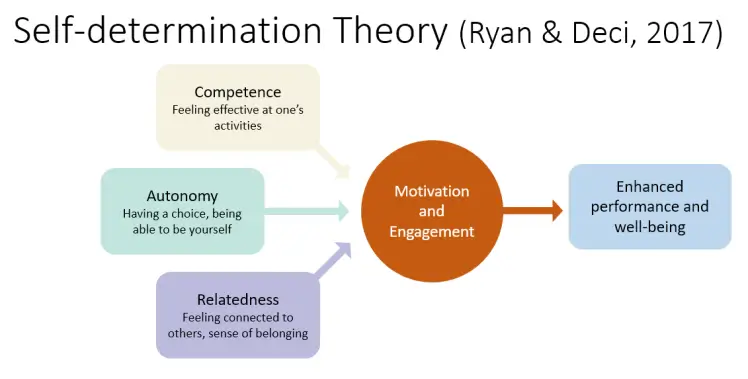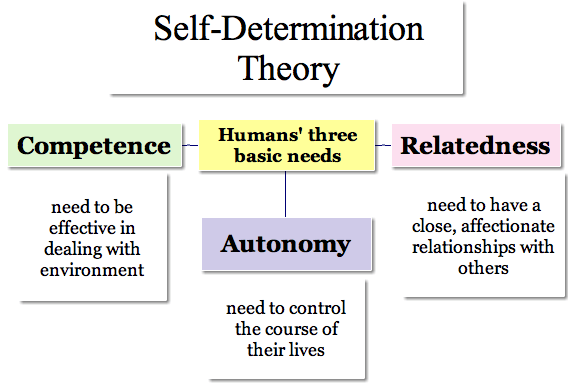What Is Self-Determination Theory (SDT) in eLearning
Discover how Self-Determination Theory (SDT) transforms eLearning by focusing on autonomy, mastery, and meaningful engagement. Unlock a learner-first future!
Discover how Self-Determination Theory (SDT) transforms eLearning by focusing on autonomy, mastery, and meaningful engagement. Unlock a learner-first future!
%20in%20eLearning.webp)
What if the secret to truly transformative eLearning wasn't more content but deeper motivation? The self-determination theory (SDT) is a research-backed framework that redefines how people engage with learning.
SDT shifts the focus from external incentives to internal drive. When that happens, engagement becomes authentic, and retention skyrockets. Modern organizations are no longer designed for passive consumption. They are trying to build ecosystems that nurture curiosity and a deep sense of ownership.
Below, we take a closer look at the three basic psychological needs identified by SDT and how they can be applied in eLearning to promote motivation and engagement.

Self-Determination Theory (SDT) is a psychological framework introduced by Edward Deci and Richard Ryan in the mid-1980s. The theory explores what truly drives human behavior, not through control or compliance, but through the natural desire to grow and learn.
It challenges the outdated notion that people only act when rewarded or punished, offering instead a model built around intrinsic motivation. Deci and Ryan's work revealed that people are most motivated when three basic psychological needs are met: autonomy, competence, and relatedness.
Autonomy refers to the freedom to make choices, and competence is the feeling of mastery and progress. Relatedness is the sense of connection to others. When these needs are satisfied, learning doesn't feel like a task but like a calling.
In the context of eLearning, SDT helps create experiences that invite agency. It doesn't force learners through rigid content.
There are two powerful ideas at the heart of self-determination. The first is this: human beings are naturally inclined to grow. In addition to being wired to survive, we are meant to evolve mentally, emotionally, and socially.
That's why learning is about pushing boundaries, mastering new challenges, and constructing a stronger sense of self through every experience.
The second core assumption is that motivation rooted in personal choice is far more sustainable than motivation driven by rewards or pressure. While external incentives, such as grades, promotions, and praise, can influence short-term behavior, they rarely fuel lasting commitment.
The true drive comes from the desire to learn and improve. When motivation comes from within, engagement deepens, and transformation becomes possible.

To grow in a workplace or a digital learning platform, people need more than content. They require three psychological nutrients.
Learners need to feel that their actions stem from personal choice, not pressure. When they can take meaningful action aligned with their own goals, their motivation strengthens. Autonomy gives learners the freedom to explore their own interests and feel in control of their learning journey.
Growth depends on the ability to meet challenges and build skills. When learners experience progress, however small, they gain confidence. That confidence fuels further effort. Consequently, a sense of mastery reinforces belief in one's potential.
People thrive when they feel connected. Whether through mentorship, peer collaboration, or shared goals, relationships play an important role in motivation. When learners feel supported and valued, it builds an emotional foundation for engagement.
There are two factors that can either strengthen or weaken the three core needs mentioned above. The first is a misuse of external rewards. When learners are already intrinsically motivated by personal goals or purpose, introducing extrinsic incentives like points or prizes can backfire.
The effect is called the overjustification effect. It occurs when external rewards start to feel like the main reason for engaging in a task. Learners may feel less ownership of their actions, which results in fading of their internal drive.
However, not all external input is harmful. Well-timed and sincere feedback can reinforce a learner's sense of competence. When feedback is focused on the learner's effort or progress, it acts as a confidence booster.
The difference lies in how external input is delivered. When rewards or feedback feel manipulative, they reduce autonomy. But when they are encouraging and supportive, they deepen intrinsic engagement.
Self-determined people move through the world with clarity and intention. They don't wait for someone else to chart their course. Instead, they take the lead.

A defining trait of such individuals is their strong sense of control over their own lives. They believe their choices matter and that effort and persistence can shape the outcomes they experience. They don't see obstacles as roadblocks but as challenges to navigate with grit.
These people get their motivation from within. They do not depend on recognition, prizes, or pressure. Rather, inner goals and personal values guide them. Their drive is rooted in meaning and a desire to grow on their own terms.
More importantly, they are intentional, so they choose actions that align with their own aspirations. They don't get pulled off track by distraction or others' expectations. Instead, they stay focused on what matters to them. Even in terms of accountability, they own their decisions and use every experience for learning.
As we've mentioned, SDT can be applicable in various walks of life, such as learning and workplace development. Below, we explain how the theory can improve your eLearning strategy.
Autonomy is the cornerstone of intrinsic motivation. In traditional learning environments, learners are often passive recipients. But in eLearning, you have the opportunity to flip the script.
You can give learners meaningful choices in your online courses. For example, you can let them select different learning pathways, content formats, and assessment types.
Suppose you're creating a leadership course. One learner may choose to explore case studies, while another prefers role-playing scenarios. Both work toward the same objective, but they have the autonomy to feel self-directed.
Autonomy can also be nurtured through flexible pacing. When learners can progress at their own speed, they're more likely to stay engaged and less likely to feel pressured or disengaged. So, build your course with checkpoints that give learners room to explore.
Competence means giving your learners the confidence that comes from mastering a skill. In an SDT-informed eLearning environment, content should be structured to stretch learners without overwhelming them.
Scaffolding is the first step here. Start with foundational material and then introduce more complex challenges. When learners see their own growth, they are likely to stay motivated. You can also offer instant feedback to let learners know what they are doing is right and where they can improve.
Also, incorporate interactive simulations and project-based assessments. These allow learners to apply their knowledge in practical contexts.
You'll need a reliable course builder to accommodate these features, and Coursebox is a good contender here. It supports interactive elements and lets you generate AI-powered assessments, which can then be graded by AI. So, you can save time while building competence through the aforementioned factors.

Instructional designers often overlook relatedness in their courses. It is the feeling of belonging and connection that's imperative to successful learning.
You can cultivate relatedness by weaving community into your platform. Discussion forums, peer reviews, and collaborative projects create a shared sense of purpose.
For example, you can invite learners to share their reflections on a topic and respond to others' experiences. Highlight contributions and celebrate shared milestones. Such meaningful interactions foster empathy and connection.
Instructors also play an important role here. Personalized feedback and video messages can make learners feel supported.
Many learners associate assessments with anxiety and even punishment. SDT offers a different perspective. It presents assessment as a tool for growth.
You should incorporate formative assessments that encourage exploration in your courses. These could be in the form of low-stakes quizzes and scenario-based tasks that allow for experimentation.
Also, make space for reflection after assessment. What did the learners discover about themselves?
Gamification can also support motivation. For example, you can offer points and badges to encourage engagement in the course. However, it should align with your intrinsic goals. Design rewards that highlight progress and learning.
An important aspect of motivation is purpose. Learners need to understand why they're engaging with the content and what value it brings to their professional lives.
So, you must gauge the deeper reason the learning material matters in your courses. Create content around real-world impacts, such as how the learner will excel at their job or solve a problem.
More importantly, connect learning to learners' broader identity. Let them visualize their growth as a journey toward becoming who they want to be. When learners feel that a course aligns with their personal goals, motivation becomes natural and sustained.
The self-determination theory (SDT) provides a human-centered approach to creating impactful learning. When you design courses that support the three psychological needs highlighted in this theory, you take content delivery a notch further to lasting growth.
More importantly, SDT-based learning teaches your learners that learning will help them grow and feel competent. So, it is a win-win situation for both you as an instructor and your learners.
Get started for free today.
